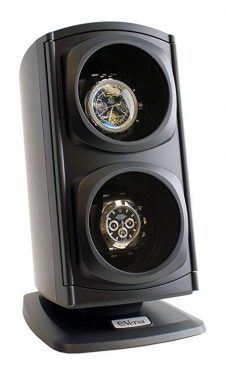What Is A Watch Winder And Do You Need One?
An automatic watch operates on the principle of winding itself using a moving weight, or balance wheel, which is inside the watch. In fact many watches use an exhibition case back which allows you to see the balance wheel move around. A watch winder is a device used to keep your automatic watch running for you when not worn.
Do you need a watch winder though? Not necessarily, you have the option to wear your watch daily. An automatic watch should run properly up to 40 hours without wearing it again. The age of your watch and temperature it is kept at can cause a watch’s lubricants to dry up, but a lack of use shouldn’t be a cause for concern. While your watch is on a winder the gears and pivots are constantly winding, causing some wear and tear. But let’s say you don’t put it on a winder, but put it in a drawer or box. It will then stop running and the balance wheel will stay in place where the gears and wheels aren’t being excessively worn.
The biggest selling point to owning a watch winder would be convenience. Yes, an automatic will stop after a couple of days spent unworn. To many, resetting the functions on a watch in the morning is enough of a nuisance to spend money for a winder.
Upon owning a watch winder, the first thing to do is to figure out your turns per day, or TPD.
Every watch winder contains a turntable, usually called a rotor. TPD stands for how many full revolutions the rotor turns in a 24-hour period. There is a certain number of turns per day an automatic watch needs to run best.
Too little TPD, and the watch will not wind fully. Too many, and you increase unnecessary wear.
 Automatic watches have different TPD settings based on their brand and type. In general, most automatic watches require anywhere from 600 to 1000 TPD in order to be wound fully. However, it is not unheard of for certain models to require more. To determine the right setting for your watch refer to your watch manual, contact the retailer you purchased the watch from or contact the manufacturer directly for more information. A watch winder will give you options on setting the turns per day, but the default setting will generally be around 650 TPD, which is great for most watches.
Automatic watches have different TPD settings based on their brand and type. In general, most automatic watches require anywhere from 600 to 1000 TPD in order to be wound fully. However, it is not unheard of for certain models to require more. To determine the right setting for your watch refer to your watch manual, contact the retailer you purchased the watch from or contact the manufacturer directly for more information. A watch winder will give you options on setting the turns per day, but the default setting will generally be around 650 TPD, which is great for most watches.
It’s also important to remember you should manually wind the watch up first, then place it in the winder. The winder will not fully wind it for you. This way, your watch will come out of the winder at its optimal mainspring tension.
A lot of luxury watches have a built-in power reserve that keeps the watch running for a set amount of time when you’re not wearing it. Most winders are built with this in mind, allowing you to set a start delay for a watch that you’ve recently worn. The start delay lets the power reserve run down before the winder starts its cycle, making sure the watch is not getting over-wound over time.
A bi-directional watch winder means that every time the winder cycles on, it turns in a different direction. While the majority of watches are just fine in a bi-directional winding unit, some watches have different specifications stating either directional or bi-directional. Again, refer to your manual for more information.
A good watch winder will have all three settings available.
Times Ticking has been in operation for more than 30 years, since 1982. We have performed watch repair for customers both locally and internationally. If it Ticks! We KNOW it! Our team of watch repair technicians have a combined experience in watchmaking of over 120 years.

